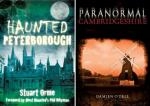
Reviewed by Tom Ruffles
Cambridgeshire’s paranormal heritage
Cambridgeshire has had a number of ghost books devoted to it, as well as appearing in many national gazetteers. For those visiting the county, the following volumes may be of interest. I have given fuller information on a couple of recent titles.
Paranormal Cambridgeshire
Having written Paranormal Hertfordshire and Paranormal Bedfordshire for Amberley, Damien O’Dell tackles Cambridgeshire in the same series, and he has packed a lot of information into his sparsely-illustrated pages. About a third of the book actually deals with Cambridge itself. The first chapter looks at Marshall’s, a major Cambridge employer and a location O’Dell has thoroughly investigated. The colleges are present and correct, of course – Jesus, Girton, Sidney Sussex, Emmanuel, Corpus Christi and Peterhouse.
Some of this will be familiar from previous efforts, but additionally O’Dell has had the benefit of being able to use cases collected by the Cambridge Paranormal Research Society (CPRS), in particular describing their investigation of the BBC radio studio in Hills Road. Other town locations are included, the best known of which is probably Abbey House, which was investigated by the late Tony Cornell and Alan Gauld of the Society for Psychical Research (the Buddhists who now own it have occasional open days, and a visit is highly recommended, though no investigations are allowed). O’Dell pays generous tribute to the SPR, which has roots in Cambridge, and in particular to Cornell, one of the Society’s best-known investigators of spontaneous phenomena.
Moving out of Cambridge, other sections cover the Huntingdon area; Ely (including Oliver Cromwell of course, who is also mentioned earlier as his head is buried at Sidney Sussex); the Fens; South Cambridgeshire, including Duxford and Linton, the latter the childhood home of Matthew Manning; and Peterborough, in addition to many other locations across the county. Peterborough has quite a long section, including a report of a 2003 CPRS vigil at its museum.
Some frequently asked questions are answered, and there is a glossary and information on investigation techniques. This is a well-written and useful guide, of particular use to those who venture outside the environs of Cambridge itself to explore the county’s fascinatingly varied geography.
Haunted Peterborough
O’Dell refers to Stuart Orme when discussing the Peterborough museum as Orme works there and participated in the CPRS investigation which O‘Dell describes in some detail. Orme has his own book on the city out, Haunted Peterborough, published by The History Press. This might not appear at first sight to be a promising destination for the ghost aficionado, and Orme himself meets head-on the charge that Peterborough doesn’t have a lot going for it. In fact, as he points out, it is very historic, with far more than the shopping centre (though the inclusion of a useful sketch map shows the extent to which Queensgate dominates), and with enough spooklore to be able to support a ghost walk, which Orme devised. Having said that, the book is well under 100 well-illustrated pages, and some of those are taken up by an afterword on ‘What is a ghost?’, a decent bibliography and (a very rare but welcome inclusion in this type of volume) an index.
As the Peterborough Museum is billed as the city’s most haunted building, quite a lot of space is devoted to it, though there is only a brief reference to the CPRS investigation; O‘Dell covers it much more fully. Other chapters deal with the cathedral, the city centre, the railway, military ghosts, and the ‘Greater Peterborough’ area. The author’s background means that he has interwoven a great deal of local history into his ghost narratives and like O’Dell he writes in a crisp unadorned style. If you ever thought that Peterborough was only good for shopping, this book will put you right.
Other Cambridgeshire titles
Some other relevant publications focusing on Cambridgeshire include the following:
Daniel Codd’s Mysterious Cambridgeshire (2010) covers a variety of ghostly, folkloric, and more generally Fortean material. Similarly broad in scope is Polly Howat’s Ghosts and Legends of Cambridgeshire (1998). Cambridge itself has been well served by paranormal guidebooks. The best of these, Robert Halliday and Alan Murdie’s Cambridge Ghosts, has gone through two editions and is written by a local historian and paranormal expert respectively. Rupert Matthews has produced a pamphlet, Haunted Cambridge, (1994). Geoff Yeates looks at one aspect of the city in his Cambridge College Ghosts: A Gathering of Ghosts, Ghouls and Strange Goings-On (also 1994). David Curry’s The Men That Never Clocked Off: Ghost Stories from Cambridge Airport (2004) is cited in O’Dell‘s chapter on Marshall‘s, but is worth a look in its own right.
Elsewhere in the county, Margaret Haynes has produced a second edition of Haunted Ely (2003), originally written in collaboration with Vivienne Doughty in 1996. A D Cornell’s Investigating the Paranormal (2002) is not just about Cambridgeshire, but many of the cases Tony investigated are located there.
There are a couple of DVDs worth checking out. Tales of the Supernatural (2008) is a compilation of historical films with an East Anglian bias, and there are a couple of Cambridgeshire stories on it. Tony Cornell is shown at Hannath Hall, near Wisbech, and the assistant butler at Peterhouse is interviewed, talking about a ghost in the Combination Room. Both of these are included in O’Dell’s book. Richard Felix has produced a DVD of Ghosts of Cambridgeshire (2008).

